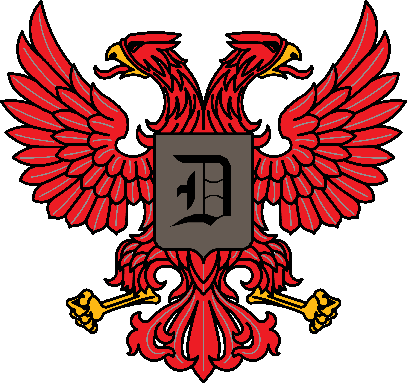 Dunlop
Manor Houses
Dunlop
Manor Houses
 Dunlop
Manor Houses
Dunlop
Manor Houses
Dunlop (Hunthall)
The pastoral estate of Dunlop is situated
nearby today's village of Dunlop in the Cunningham district of Ayrshire, about
30 miles southwest of Glasgow, Scotland. After Scottish King Malcolm annexed the
Kingdom of Strathclyde, he started the feudalization of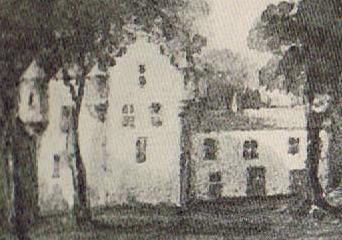 the entire area.
the entire area.
His successor, King David, granted Cunninghame to a de Morville, who was appointed Hereditary Constable and built a castle at Kilmaurs. His vassal, Dom Godfrey De Ross, was then given the Fortress on Dunlop Hill. He called the site Boarland and also Overhill. There are no traces of the original castle on the Hill today, although the remains of a wide ditch can be seen on the southern face. The original castle on the Hill bore traces of the fortifications added another De Ross who had sided with the Balliol faction against Bruce in the early 14th Century contest for the Scottish Crown. Subsequently, De Ross had to forfeit his lands. Those De Ross's were the last inhabitants on the Hill.
The hereditary Celtic Chief of Dunlop Hill, being appointed the Huntsman for the Norman De Ross, was given land (circa 1066) to build a large manor house on the banks of the Clerkland Burn. Dunlop House (the fourth in a series) now stands on this site. The main branch of the Dunlop Family resided at this Clerkland estate, called Hunthall.
Pont says, "Dunlop, one ancient stronghouse, fortified with a deep boat of water, and planted with goodly orchards. It is named Hunthall because, say they, the ancient bounds and grounds thereabout, and all Macharnoch Moore, as of olde, a mighty forest." The castle or stronghouse of Dunlop stood on the banks of a little rivulet called Clerkland burn, which divided the parish from Stewartstown. It is unknown at what time the original square tower was erected. One of the more modern additions bore the date 1599(see above right). The site is now occupied by the handsome modern mansion, (see above left) built by the late Sir John Dunlop, Baronet, in 1835.
The Chief (Dunlop of Dunlop) had built his manor in 1066 on the banks of the Clerkland, on land given him by De Ross. With the departure of The de Ross's in the 14th Century, the Dunlops became the Family of most consequence in the area. This Manor was the first of four buildings built there as the House of the Family Dunlop. This estate was then owned and occupied by the family over 598 years. The second House was finished circa 1304, and the third addition started in 1599. The original structure was demolished to make way for the new and current Dunlop House built in 1835. See Dunlop Royalty for the line of Dunlops of Dunlop
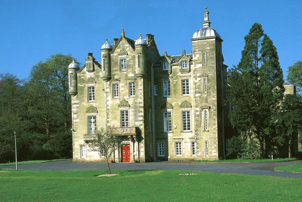

Gankirk

The estate of Garnkirk is about six miles north-east from Glasgow, and in the parish of Cadder. The turnpike road to Cumbernauld intersects the lands. The present house was built, on the site of an ancient mansion, about 1820, from designs by David Hamilton, architect.
Anciently, Garnkirk belonged to the Church, and was first secularized in 1587, by charter from the Commendator of Glasgow, to John Stirling, son of Stirling of Balquharrage, a cadet of the Stirlings of Cadder. The purchaser of Garnkirk espoused a daughter of Boyd of Badenheath, in the vicinity, an old cadet of the family of Lord Boyd. The Garnkirk Stirling had several sons who settled in Glasgow, and became well known merchants.
On 10th March 1634, "Robert Stirling in Garnkirk, and John Stirling, his eldest "lauchful sone," conveyed "the town and lands of Garnkirk" to "Mr. John Dunlop, merchant burgess of Glasgow, and Elizabeth Dunlop his spouse, and longest liver."
This John Dunlop was third son
of James Dunlop of that Ilk, near Stewarton, a very old Ayrshire family.
Besides being a merchant,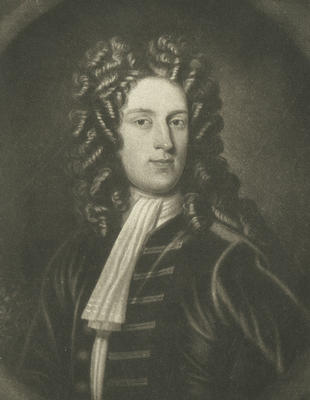 John Dunlop appears to have been a sort of
banker, or dealer in money, and a rich man. He built the original mansion house
of Garnkirk, and died in March 1662. He was succeeded by his only son James, who
was a member of the Faculty of Procurators in Glasgow.
John Dunlop appears to have been a sort of
banker, or dealer in money, and a rich man. He built the original mansion house
of Garnkirk, and died in March 1662. He was succeeded by his only son James, who
was a member of the Faculty of Procurators in Glasgow.
James Dunlop espoused Elizabeth, daughter of James Roberton, advocate, afterwards Lord Bedlay. This marriage took place on 5th April 1654. The marriage contract is still extant, with the signatures of both John Dunlop and James Roberton, parents of the bridegroom and bride, as consenters, and granters of certain provisions.
Garnkirk remained the property of the lineal descendants of John Dunlop, through three generations, all the successive owners having been named James, and all of them having had large families. The second, James, a lawyer, had no less than sixteen children, between February 1690 and 31st July 1709, and his wife, a daughter of Robert Campbell of North-woodside, died in childbed of the last son, at the early age of thirty-four. The names, and dates of birth, of this numerous family, as well as the death, and age of their mother, are preserved in a holograph writing drawn out by the father.
The last of the three James Dunlops of Garnkirk died there, on 3rd August 1769. After his death the estate was sold, and purchased in 1782 by his nephew, James (son of his younger brother Provost Colin Dunlop of Carmyle), who thereupon took the title of James Dunlop of Garnkirk. He was father of the well known Colin Dunlop of Clyde ironworks, who some time represented Glasgow in Parliament, with Mr. Oswald, shortly after the passing of the first Reform Bill. Mr. James Dunlop was also uncle of the late Mr. Colin Dunlop Donald, Commissary Clerk, who was named after his maternal grandfather.
During the ownership of the last mentioned James Dunlop, he put a new front on Garnkirk House, as now seen. The estate was sold in 1799, to John M'Kenzie, merchant in Glasgow. It changed owners again in 1811, by sale to the Trustees of the then deceased Mr. Mark Sprot, whose nephew of the same name, and a member of the Faculty of Advocates succeeded. This latter gentleman, about 1820, rebuilt the old mansion of Garnkirk, allowing the front put up by Mr. Dunlop to stand, so that the house as it now exists is the combined result.
(1878).
THE DUNLOPS OF GARNKIRK.
The Dunlops of Garnkirk, now represented here by James Dunlop of Tollcross, are a very interesting old Glasgow family, and the following detailed account of them and their numerous descendants, seems a fitting sequel to the above.
I. - JOHN DUNLOP, first of Garnkirk, married Elizabeth Dunlop and died in 1662, leaving one son.
II. - JAMES DUNLOP, second of Garnkirk, who married, about 1654, Elizabeth, daughter of James Roberton of Bedlay, and had six sons and three daughters. He died in 1695. His family were - (I.) James, the eldest, of whom afterwards, (the third laird of Garnkirk); (II.) John, who died unmarried in 1683; (III.) William, merchant in Glasgow, married and had a family, of whom nothing, however, is known; (IV.) Alexander, died abroad; (V.) Thomas, was "a chirugean apothecary" in Edinburgh; he married and had a family who are now, however, unknown; (VI.) Archibald, was a merchant trading to New York and the Spanish Main. (I.) Jean, the eldest daughter, married, firstly, Robert Campbell of North Woodside, second son of Colin Campbell of Blythswood, and had an only daughter, Janet, who married, in 1701, Thomas Haliburton of Dryburgh Abbey : they had a large family. Jean Dunlop married, secondly, Patrick Coutts, "merchant burgess" of Edinburgh, and had two sons and a daughter. The eldest son was John Coutts, born 1699, banker in Edinburgh, and Lord Provost in 1742. He was father of Thomas Coutts who went to London and founded the famous banking firm of Coutts and Co., and was grandfather of the Baroness Burdett Coutts; (II.) Elizabeth, married in 1688 John Rae of Little Govan; (III.) Margaret, died unmarried.
III. - JAMES DUNLOP, third of Garnkirk, married, 1689, Lilias Campbell, only daughter of Robert Campbell of North Woodside, by his first wife Katherine, second daughter of John Napier of Kilmahew : they had sixteen children : Mrs. Dunlop died at the birth of the sixteenth in 1709, aged 34. James Dunlop married, secondly, Mary Douglas, but by her he had no family. He died in 1719. His children by his first wife were - (I.) Robert, born 1690, and died young; (II.) James, born 1697, of whom afterwards (the fourth laird of Garnkirk); (III.) Robert, born 1700, became a prosperous merchant in Glasgow, and bought from Andrew Blackburn, Househill, a property which was acquired by his great-grand-uncle, Thomas Dunlop, in 1646, and afterwards sold to the Blackburns (see Househill); (IV.) John, born 1702, was apprenticed to Francis Congalton "chirugeon apothecary," burgess of Edinburgh, but nothing further is known of him, and he probably died without issue; (V.) Thomas, born 1704, was a Virginia merchant in Glasgow, of the firm of Thomas Dunlop and Co. He had a very fine house on the west side of the Candleriggs, nearly opposite what is now the City Hall. He died unmarried in 1783 aged 79; (VI.) Colin, born 1706, was a rich Virginia merchant in Glasgow. He purchased Carmyle and was Provost in 1770. His eldest son was James Dunlop, who in 1782 bought Garnkirk from his uncle, James Dunlop the fourth of Garnkirk (see Tollcross for a full account of Provost Colin Dunlop's family and descendants); (VII.) William (a twin), born 1708, married Mary Boyd, only daughter of "a genteel and wealthy family in Ireland." They had two daughters, Martha and Mary, who both died very old and unmarried, and one son, Robert, who married Catherine, fourth daughter of John Corbet of Tollcross. This Robert Dunlop had a daughter, Janet, who never married, William, a captain in the army, whose family are settled in Ceylon, and Boyd, who had two daughters, Helen, Mrs. R. A. Morehead, and Catherine of Albyn Place, Edinburgh, and one son, Robert, who went to Australia; (VIII.) Archibald, born 1709, died 1719. (I.) The eldest daughter died an infant; (II.) Elizabeth, born 1692, died an infant; (III.) Jean, born 1693, married Thomas Peter of Crossbasket, and died 1729; (IV.) Katherine, born 1695, married to William Douglas of Leith, she died aged upwards of ninety. They had two sons and one daughter unmarried. Robert, the eldest son, married and had a family; his descendants mostly went abroad. Their second son, John Douglas, became a merchant in Glasgow. He married Cecilia, daughter of George Buchanan, brewer, Bailie 1732 (see Mount Vernon), and had by her seven sons and one daughter, viz.: 1) William; 2) John; 3) Cecilia; 4) Neil (afterwards Sir Neil, G.C.B.); 5) Thomas Dunlop, a well-known citizen of Glasgow, who afterwards bought the estate of Dunlop, and died in 1869 aged 94; 6) Archibald; 7) James; 8) Colin. (V.) Lillias, born 1696, died unmarried; (VI.) Elizabeth, born 1698, married to Robert Rae of Tannochside. Their son was Colin Rae of Little Govan, Aitkenhead, Polmadie, &c.; (VII.) Janet, born 1701, died 1711; (VIII.) Margaret, a twin, born 1708, and died young.
IV. - JAMES DUNLOP, fourth of Garnkirk, born 1697, married, first in 1722, "Henrietta Maxwell, daughter lawful to George Maxwell of Southbar, in the citie of Glasgow," and by her he had five sons and six daughters. He married, secondly in 1749, "Mrs. Jean Campbell in the citie of Glasgow." She was a widow of the ripe age of 65, thirteen years older than Mr. Dunlop. She died in 1759, without issue, aged 75. Mr. Dunlop married, thirdly, in 1761, Margaret Hamilton, daughter of Hamilton of Cochna. By this marriage there were no children. Mr. Dunlop died at Garnkirk, 3rd August, 1769, aged 72. The children of his marriage were - (I.) James, married 1753, Mary Ritchie, daughter of John Ritchie of Craigton. He died leaving two sons and five daughters. The elder son, James, married and had twelve children, the eldest of whom was James, a judge of Georgetown, Maryland, United States. He was therefore the direct heir of line and male representative of the old lairds of Garnkirk. The brother of the judge, named George, died unmarried. The five granddaughters of the last laird by his eldest son, James, were - 1) Helen; 2) Henrietta; 3) Margaret; 4) Mary; 5) Grace; all died unmarried except Henrietta. She became the first wife of Captain Robert Davidson, and dying left one son, James, who died young, and one daughter, Margaret. This lady was married, first, to the late Gilbert Watson, banker in Glasgow, and secondly, to Dr. David Patrick of Athole Place, Glasgow, without issue. She was the nearest surviving direct descendant in this country of the last old laird of Garnkirk, who died in 1769. She had a number of interesting portraits of the old Dunlops; she died in 1870, and the pictures now belong to James Dunlop of Tollcross, who is now the representative in this country of the old Dunlops of Garnkirk. (II.) George, died young. (III.) Robert, died young. (IV) William, died young. (V.) Thomas, died young. (I.) Grizel, the eldest daughter, married Andrew Sym, merchant in Glasgow, and had four sons and five daughters: 1) John Sym, merchant, "Gallowgate Bridge." 2) Robert Sym, born 1752, became a Writer to the Signet in Edinburgh, a man greatly esteemed, and one of the tallest and handsomest men in that city. He died unmarried. 3) James Sym, merchant in Glasgow, married Miss Melville and had issue. 4) Andrew Sym, merchant in Glasgow, died unmarried. 1) Margaret, the eldest daughter, married John Wilson of Paisley, and had a large family, of whom the eldest was Professor John Wilson of the University of Edinburgh, well known by his writings and his connection with Blackwood's Magazine. 2) Henrietta, married, 1771, Archibald Hamilton of Overtoun, Lanarkshire, about the end of last century agent in Glasgow for the Paisley Bank; their children were Captain Andrew Hamilton, long proprietor of the "Glasgow Courier," who died in 1856 leaving two daughters, - and two daughters, Mrs. Robert Garden and Mrs. Tatnall. 3) Catherine, died unmarried about 1844. 4) Grace, was the second wife of Captain Robert Davidson; no surviving issue. 5) Agnes, married James Robertson, merchant and banker in Glasgow - issue one daughter. (II.) Henrietta, married James Douglas of Mains (see Mains). (III.) Lilias, married in 1750 George Buchanan, merchant in Glasgow (see Mount Vernon). (IV.) Elizabeth, married Hugh Wyllie, merchant, Glasgow, Lord Provost in 1780. They had two sons and one daughter: 1) Hugh, settled in America; 2) John, went to sea and died unmarried; 1) The daughter married John Hay, of the firm of Hay, Barclay and Co., King Street, Glasgow (the John Barclay of this firm was the father of the well known Hugh Barclay, Sheriff-Substitute of Perthshire). Mr. Hay afterwards became proprietor of the estate of Morton in Fifeshire, which is still in the family. (V.) Jean, married Robert Marshall, a native of Kendal, who settled in Glasgow about the middle of last century, and became a partner and manager of the extensive concern of the "Glasgow Tanwork Company," which commenced soon after the union. The Marshalls had three sons and three daughters: 1) Robert, law agent for his cousin, Mr. Campbell of Blythswood, - he died unmarried; 2) Thomas, died unmarried; 3) Captain William Marshall, died unmarried at Rothesay, 1864, aged 90 years. Of the daughters, the first and third died unmarried, the second, Agnes, was a great beauty - she married Campbell Douglas of the Mains family. They had one son, John Campbell Douglas, who succeeded to that estate (see Mains). (VI.) Marion, died unmarried.
This note has thus given in detail the descendants of the four old lairds of Garnkirk. The descendants of James Dunlop, the nephew of the fourth old laird, and who bought the estate in 1782 from his uncle's representatives, and who held it for about ten years, will be found in the notice of Tollcross, where Provost Colin Dunlop of Carmyle and his family are treated of.

Househill
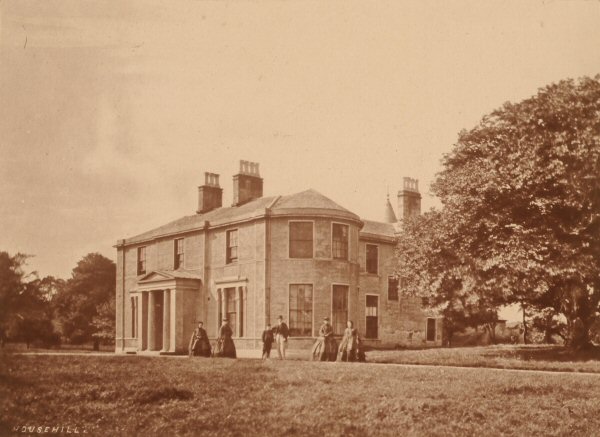
The property of Robert Buchanan Dunlop, Esq., of Drumhead and Househill, is pleasantly situated in the parish of Paisley and county of Lanark.
In 1477 Sir Thomas Stewart of Minto, who was Provost of Glasgow in 1472, had a charter from John, Earl of Lennox, of the lands of Househill, confirmed by royal charter in 1489. (1) His descendants held them till 1646. About this time the fortunes of the Stewarts seem to have been on the decline. Sir Ludovick was obliged to sell the Glasgow properties as well as the landward ones, such as Daldowie and Househill, the latter of which was acquired by Thomas Dunlop in the year last mentioned.
Thomas Dunlop was the fifth son of James Dunlop of Dunlop, an ancient family in the neighbouring county of Ayr. He married Grissel, daughter of Alexander Cochrane of that Ilk. He was succeeded by his son James, who in his turn was succeeded by his son, another James. This James Dunlop sold the estate to John Blackburn. (2)
John Blackburn, merchant in Glasgow, was the son of William Blackburn, who married Margaret Murdoch in 1682. (3) William Blackburn was a merchant in Glasgow, and in the list of the "great company" which "arose undertaking to trade to Virginea, Carriby Islands, Barbadoes, New England, St. Christophers, Monserat, and other colonies in America," he and his two sons, John and William, are included. (4)
His eldest son, John Blackburn, who bought Househill, married Marion Cathcart, and had, in 1719, his eldest son Andrew.
Andrew Blackburn was one of the public-spirited and enterprising merchants who in the middle of last century founded the early Glasgow Banks. In 1750 the well-known Glasgow Arms Bank was started, and his name appears among the original partners. He married Margaret, daughter of Andrew Aiton, merchant in Glasgow. In 1750 Andrew Blackburn sold Househill to Robert Dunlop, and he afterwards resided in "Ingram's" Street in Glasgow.
Robert Dunlop of Househill was a merchant in Glasgow, and second surviving son of the second James Dunlop of Garnkirk. He and his brother, Provost Colin Dunlop of Carmyle, were among the founders in 1750 of the Ship Bank. He married, first, Elizabeth, daughter of John Baird, merchant in Glasgow, by whom he had one daughter, Jane, who married Robert Dinwiddie of Germiston. He married, secondly, Janet, second daughter of Archibald Buchanan of Drumhead, Dumbartonshire, and had issue two sons and two daughters, viz.:-
1st, James, who succeeded to Househill in 1762, and had four daughters, co-heiresses. On the failure of the direct line in these, the estate passed to the Drumhead branch in the person of the present proprietor.
2nd, Robert, who succeeded to Drumhead as heir of entail, and whose great-grandson. Robert Buchanan Dunlop, is now proprietor both of Drumhead and Househill. The daughters were - Lilias, married to Robert Muirhead of Croy, merchant in Glasgow, who died without issue, and Dorothy, wife of Robert Findlay, merchant in Glasgow. (5)
The old house of Househill is described by Crawford as "a neat and handsome dwelling," and Hamilton says that "Howsle" is "a pretty dwelling and a reasonable good house." The modern mansion, which was built about the beginning of the century, is a comfortable residence.
(1) Douglas, Vol. II., p. 212.
(2) Crawford.
(3) The Blackburns have been long connected with Glasgow. This William Blackburn, who married Margaret Murdoch in 1682, was the father of two sons as mentioned above, and a daughter, Isabel. Isabel Blackburn was the first wife of Samuel M'Call, merchant in Glasgow, whom she married in 1707: they had three children, only one of whom, Samuel, survived; he went to America and settled there, and his descendants, who retain a warm feeling of affection for the country of their ancestor, are a flourishing race. Samuel M'Call married, secondly, Margaret Adam, who is the ancestor of the M'Calls who are mentioned elsewhere in this book.
John Blackburn of Househill, son of William Blackburn and Margaret Murdoch, married Marion Cathcart, and had three sons, viz.:-
I. Andrew, who married Margaret, daughter of Provost Aiton of Glasgow; their eldest daughter married John Wedderburn, and had four children - 1, Andrew Wedderburn Colvile, father of the present Right Hon. Sir James Colville; 2, Peter Wedderburn Ogilvy of Ruthven; 3, James Wedderburn, Solicitor-General, two of whose daughters, Jean and Jemima, married respectively Peter Blackburn of Killearn, and Professor Hugh Blackburn; 4, Jean, married fifth Earl of Selkirk.
II. Peter, who married Helen Cross, sister of William Cross of Parkhouse, and John Cross, ancestor of Auchintoshan, and had three daughters, Martha, Agnes, and Marion, who all died unmarried, and one son, John, who made a fortune in Jamaica, and purchased the estate of Killearn in Stirlingshire. He married Rebecca Leslie Gillies, daughter of the Rev. Colin Gillies of Paisley. Colin Gillies was the son of the Rev. John Gillies, D.D., of the College Church, by a daughter of the Rev. John Maclaurin, D.D., one of the ministers of Glasgow, author of the well-known sermon "On Glorying in the Cross of Christ,'' and brother of Colin Maclaurin, the celebrated mathematician. John Blackburn of Killearn's family were - 1, Peter, late of Killearn, formerly chairman of the Edinburgh and Glasgow Railway, and late M.P. for Stirlingshire, and a Lord of the Treasury; he married Jean Wedderburn, and had issue; 2, Sir Colin, Justice of the Queen's Bench, created in 1876 Baron Blackburn of Killearn, in the Peerage of the United Kingdom, for life, unmarried; 3, John, married Maria Warburton, and has issue; 4, Isabella, unmarried; 5, Andrew, married Mary Buchanan, and has issue; 6, Robert, Sheriff of Stirlingshire, married Georgina Dewing, and had issue; 7, Hugh, Professor of Mathematics, University of Glasgow, married Jemima Wedderburn, and has issue; 8, Helen, married Robert D. Ferguson, and has issue.
III. Hugh had a daughter named Hugh (!), who married Alexander Bruce of Kennet, and is the grandmother of Alexander Hugh Bruce of Kennet, who lately proved his right to the title of Lord Balfour of Burleigh.
(4) M'Ure.
(5) He was the son of the Rev. Dr. Robert Findlay, Professor of Theology in the University of Glasgow, of an Ayrshire family. The grandson of the Rev. Professor was the late Robert Findlay of Easterhill, a well known Glasgow merchant; he married Mary, daughter of John Buchanan of Ardoch, and had five sons - Robert (died unmarried), John of Boturich, James, Charles Bannatyne, Thomas Dunlop - and six daughters.
Source:The old country houses of the old Glasgow gentry

Rosebank
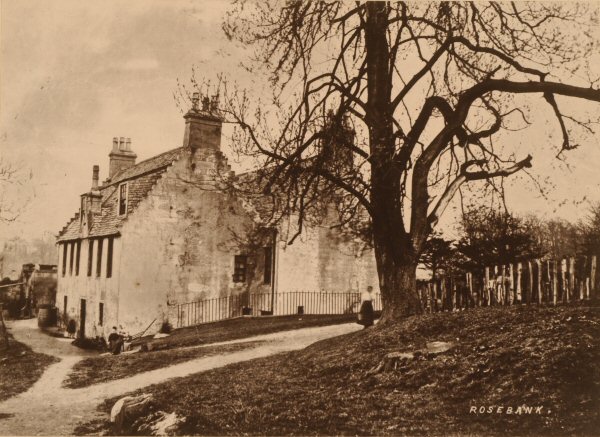
ROSEBANK is situated on the left bank of the Clyde, in the parish of Cambuslang and county of Lanark, about four miles from Glasgow. It is a feu from the barony of Drumsargat, which came into the possession of the ducal house of Hamilton about 1455. It was originally about fifty acres in extent.
Early in last century it belonged to Provost John Murdoch, son of old Provost Peter Murdoch and Mary Luke of Claythorn. His daughter, Margaret Murdoch, married Lord President Sir Thomas Miller of Glenlee, and towards the end of last century Rosebank became the property of their son-in-law, John Dunlop, another Provost, son of a Provost.
John Dunlop, merchant in Glasgow, was a younger son of Provost Colin Dunlop of Carmyle, and was himself Provost in 1794. In 1789 his town residence was on the east side of Queen Street, and he afterwards, in 1793, bought a house and garden in Virginia Street which had been long occupied by George Oswald of Scotstoun, and before him by Alexander Spiers of Elderslie.
John Dunlop was a man of taste, and, taking advantage of a fine situation and beautiful wood, made Rosebank one of the very sweetest places on the Clyde. He was a wit and a poet as well, and wrote several pieces, among which are the beautiful songs "Here's to the year that's awa," and "O dinna ask me gin I lo'e ye." He was afterwards Collector of Customs at Bo'ness and Greenock, and died 4th September 1820. His son, John Colin Dunlop, Advocate, was many years Sheriff of Renfrewshire, and was well known as the author of the "History of Fiction" and other works of merit. He died unmarried on 26th January 1842, an only child, and his father's direct line terminated with him. Rosebank had been sold in 1801 to David Dale.
Rosebank was afterwards acquired by the Caledonian Railway Company, by whom it was divided into two parts. One of these was bought by Thomas Gray Buchanan of Scotstoun, whose property and residence of Wellshot adjoined. The other, including the house, was bought by the Messrs. Dunlop of the Clyde Iron Works, who immediately afterwards sold almost the whole of their purchase to John Bain of Morriston, and his representatives are now [1870] the proprietors.

Tollcross

The property of James Dunlop, Esq., is situated in that part of the Barony parish now erected into the parish of Shettleston, in the county of Lanark, and about three miles distant from the Cross of Glasgow.
It is near the village of Shettlestone, the ancient Schedinestun, and its name is probably derived from the circumstance of Rutherglen, to which the whole district of Glasgow belonged of old, levying toll or custom at the Cross of Shettleston ("Ad crucem de Schedinestun"), the Royal Burgh being prohibited by Alexander II., in 1236, from intruding itself further than this point into the Bishop's territory. (1)
Schedinestun was granted, in 1242, by Alexander II., to William, Bishop of Glasgow, and his successors, and Tollcross, doubtless, formed a portion of it.
This latter property was originally larger than it is now, Easter Camlachie, which was part of it, having been feued off early in last century, and what was anciently called the "Little Hill of Tollcross," which was afterwards known as Jeanfield, and is now the Eastern Necropolis, having also been feued in 1751 by James Corbet.
The Corbets were a family of great antiquity. Roger Corbet was one of the Barons of Scotland who swore fealty to King Edward I., of England, about 1296. Crawford, in his "Remarks on the Ragman Roll," says that he was of the family of Mackerston, and that a branch of the same house has "for several centuries past resided in Clydesdale, in the Regality of Glasgow." This was the family of "Tollcross."
At the beginning of the seventeenth century "Mr. James Corbet of Towcors" is mentioned in the Commissary Records of Glasgow. Waller Corbet of "Towcorse" was living in 1678, and is alluded to in connection with some of the religious difficulties of the time. (2) When Nisbet published his "System of Heraldry," in 1722, the armorial bearings of "Walter Corbet of Towcross" are given, and the family continued to hold the estate till the beginning of the present century, (3) when it was sold to James Dunlop, the eldest son of Colin Dunlop of Carmyle, and grandson of the second James Dunlop of Garnkirk. (4)
Colin Dunlop of Carmyle was born in 1706. He was the thirteenth child of the second James Dunlop of Garnkirk, by his wife Lilias, only daughter of Robert Campbell, of Northwoodside, merchant in Glasgow, by his first wife Katherine, second daughter of John Napier of Kilmahew, Dumbartonshire. (5)
Colin Dunlop was one of the founders of the commercial greatness of Glasgow. He established the firm of Colin Dunlop & Sons, one of the great Virginia houses. Along with his brother Robert of Househill, and a few of the principal merchants of Glasgow, he also originated, in 1750, the first Glasgow Bank, "The Ship." He was a Bailie in 1747 and 1761, Dean of Guild in 1759, and Provost in 1770. His town residence, which still exists, though sadly changed from its original appearance, was built about the middle of last century, and was the second of the new houses erected outside of the West Port, when, what is now Argyle Street, was widened and improved circa 1750. The first of these new buildings was Provost John Murdoch's mansion, afterwards the well-known "Buck's Head Inn." Colin Dunlop's house was next to it, and is now the oldest house in Argyle Street. It is the second building east from Dunlop Street, which was formed on his property and named after him. He died in 1777.
His son, James Dunlop, was born 1742. He acquired Garnkirk from the representatives of his uncle, the third James Dunlop, and added largely to his landed property by the purchase of estates in the neighbourhood of the old family place. Along with his father and brother John, of Rosebank, he carried on the Virginia business, and the great house of Colin Dunlop & Sons seemed established on the firmest footing and to be at the height of its prosperity when a sudden and most severe "monetary crisis" occurred in 1793, and the firm was obliged to succumb. Garnkirk and the other estates were then sold, James Dunlop retaining the superiority and minerals of Carmyle, which are still the property of his grandson.
After the great tobacco house thus came to a close James Dunlop engaged in the business of mining, and, as a coal master, worked the minerals upon Carmyle. He purchased, as already shown, about 1810, the house and part of the lands of Tollcross, and died there in 1816. He was succeeded by his eldest son, Colin Dunlop.
This well-known citizen of Glasgow was born in 1775. He was bred to the bar and passed advocate, but never practised. He purchased the Clyde Ironworks, and under his energetic management raised them to the high position they now hold. He was a keen Whig politician, and one of the great leaders of the Reform party in Glasgow.
In 1835, along with James Oswald, he was elected M.P. for the city. He died, unmarried, in 1837, and was succeeded by his nephew, James Dunlop, who is also proprietor of the Clyde Ironworks,
The estate of Tollcross has been considerably added to since it was purchased by the Dunlops. There has long been a mansion on the property. In 1710, Hamilton of Wishaw, when describing the Barony parish, says of "the Towcorse" that it is "a good and substantious house, with good gardens and inclosures."
The present handsome edifice was built, in 1848, from the designs of David Bryce, architect, Edinburgh.
THE DUNLOPS OF TOLLCROSS.
Colin Dunlop, thirteenth child of James Dunlop, second of Garnkirk (which see), married Martha Bogle, daughter of John Bogle of Hamilton Farm. Her mother was a daughter of George Murdoch, Provost of Glasgow in 1754. He had two sons and one daughter.
I. JAMES, who bought Garnkirk from his uncle's trustees (see Garnkirk), born 1742, married Marion Buchanan of the Drumpellier family, by whom he had four sons and three daughters. He died at Tollcross 1816, aged 74. (I.) Colin, his eldest son, born 1775, passed advocate in 1799. In 1835 elected M.P. for Glasgow, died unmarried in 1837, aged sixty-two. (II.) George, W.S., born 1777, married Isabella, daughter of William Simpson of Ogle, county of Forfar, and had three sons and two daughters, (I.) James Dunlop, now of Tollcross, married firstly Janet Donald (see Mountblow), and had issue one son, George James, and three daughters; secondly, Louisa Locke, widow of William Lawrence Colquhoun of Clathic. (2.) George, W.S., married Miss Spens, and has issue. (3.) William, parliamentary solicitor, married Miss Burney, no issue. (4.) Colin Robert of Quarter married first Helen M'Call, and had issue George and Colin; second, Anne Black, and had issue; third, Helen Hamilton. (1.) The eldest daughter is Isabella, unmarried; (2.) the second daughter died young. (III.) John, a merchant in London, born 1779, died 1830. He had two sons - James, settled in America; Donald, a barrister in London; and two daughters, who died unmarried. (IV.) James, of Lloyds, London, died a bachelor. (I.) The eldest daughter Lilias, born 1778, died at Tollcross 1818. (II.) Martha, died unmarried. (III.) Marion of Gogar Mount, died unmarried in 1868, aged 83 years.
II. JOHN, born 1744 (see Rosebank).
I. JANET, married 1773 Thomas Donald of Geilston (see Mountblow).
Source:The old country houses of the old Glasgow gentry

Garbraid

GAIRBRAID is situated on the left bank of the Kelvin near Maryhill, in the Barony parish, and four miles from the cross of Glasgow. The old mansion was built in 1688, and near it was erected in 1789 the present house.
In ancient times the lands of Gairbraid, which were formerly Church lands held by Rentallers under the Archbishopric of Glasgow, belonged to a family named Hutchison. A charter is extant, in favour of John Hutchison described as then "in Gairbraid," by Robert Montgomerie, Archbishop of Glasgow, dated 19th November, 1582, while Queen Mary was a prisoner in England.
It is generally said by local writers that the Hutchisons of Gairbraid were ancestors of George Hucheson, (1) founder of the Hospital. But this is an entire mistake. The two families were not directly related to each other. The parents of the benevolent founder of the charity were Thomas Hucheson of Huchesonton and Lambhill, and Helen Herbertson, spouses. This Huchesonton property formed part of the lands of Nether Carmyle, immediately to the eastward of what is now the Clyde Iron Works. George Hucheson purchased Gairbraid in 1600 from the other family of Hutchison already referred to. The mistake now pointed out seems to have originated with M'Ure, the confused old chronicler, and has since been slavishly copied in the face of authentic documents to the contrary, extant in the charter chest of the Hospital.
Neither George Hucheson of Gairbraid, nor his brother Thomas, had any family. In 1639 and 1641 respectively they mortified a portion of their means to endow the Hospital, and this mortification was in the latter year confirmed by their three widowed sisters, Mrs. Duncan, Mrs. Pollock and Mrs. Ninian Hill. Ninian, the son of the last named, succeeded to the heritable estates, and Lambhill was sold by him in 1696 to the ancestor of the present proprietor, William Graham. Ninian was succeeded in Gairbraid by Hew Hill; he left an only daughter, Mary, who succeeded. (2)
Mary Hill of Gairbraid married, previous to 1763, Robert Graham of Dalsholm, of the Dougalston family. They had two daughters, Lillias and Janet. Lillias died unmarried previous to 1836. Janet married Alexander Dunlop of Keppoch, merchant in Greenock, and had with other issue John who succeeded. Alexander Dunlop married secondly Margaret, daughter of William Colquhoun of Kenmure, and had issue, of whom the eldest was the late Alexander Colquhoun Stirling Murray Dunlop, formerly M.P. for Greenock.
Gairbraid now belongs to Alexander Graham Dunlop (3) and William Carstairs Dunlop, the surviving members of the family of the late John Dunlop of Gairbraid.
The estate is not a large one, but it is now very valuable in consequence of the numerous feus from it for the rapidly growing burgh of Maryhill. (4)
Gairbraid is much altered since this photograph was taken. In fact the old place may be said to be gone. The magnificent avenue of beech trees has been cut down, the woods on the banks of the Kelvin have been ruthlessly swept away, and the old house now stands naked and forlorn amidst a wilderness of "free coups," broken bottles and bricks, pools of dirty water, clothes lines fluttering with parti-coloured rags, and all the abominations of a new suburb. Instead of the singing of birds and the music of the soft flowing Kelvin, which of yore pleased and refreshed the passer-by, the air is now vocal with the discordant voices of rough men, scolding women, and "greeting bairns," and with the clang of machinery and the hiss of the steam engine.
(1) This is the way that the Hospital founder wrote his surname.
(2) For an account of this old family of Hills see "Barlanark".
(3) Alexander Graham Dunlop was formerly Her Majesty's Council General and Royal Commissioner at the Havana.
(4) This village is named after Mary Hill, only daughter and heiress of Hew Hill of Gairbraid, in whose time it was founded.
Source:The old country houses of the old Glasgow gentry

Corsock
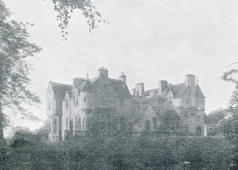 "Corsock
- Captain Henry Liston Murray Dunlop - is the principal mansion house and
property in the upper part of the valley. It is a place of considerable
antiquity. The earliest known mention of it is in a charter from King David II
about 1346. For three hundred years there were Neilsons of Corsock, a worthy,
and at one time influential, family, now mostly forgotten. The first of these
was John Neilson, who, along with his wife, Isabel Gordon, was declared
proprietor in 1439. The most distinguished of this family was also a John
Neilson, who for his unswerving attachment to the Church of the Covenants was
cruelly persecuted, fined, and harassed in various ways, driven from his home,
as also were his wife and children, tortured with the savage " boot" (a practice
not used in Scotland for forty years before), and finally put to death at
Edinburgh, 14th December, 1666. The last of this family was still a John
Neilson, who sailed for South Carolina in 1748, no doubt hoping to retrieve the
fortunes of his household, now fallen to a low ebb, and who died there in 1749.
Between 1749 and 1846 there were at least two families who succeeded in
possession of Corsock-Wylie and Fletcher. In 1846 the property was bought by
John Murray, Edinburgh. He died in 1849. His only child married Alexander
Dunlop, who added his wife's name to his own, and was known as Alexander Murray
Dunlop. The descent of this gentleman from the Dunlops of Dunlop, in Ayrshire,
is interesting :
"Corsock
- Captain Henry Liston Murray Dunlop - is the principal mansion house and
property in the upper part of the valley. It is a place of considerable
antiquity. The earliest known mention of it is in a charter from King David II
about 1346. For three hundred years there were Neilsons of Corsock, a worthy,
and at one time influential, family, now mostly forgotten. The first of these
was John Neilson, who, along with his wife, Isabel Gordon, was declared
proprietor in 1439. The most distinguished of this family was also a John
Neilson, who for his unswerving attachment to the Church of the Covenants was
cruelly persecuted, fined, and harassed in various ways, driven from his home,
as also were his wife and children, tortured with the savage " boot" (a practice
not used in Scotland for forty years before), and finally put to death at
Edinburgh, 14th December, 1666. The last of this family was still a John
Neilson, who sailed for South Carolina in 1748, no doubt hoping to retrieve the
fortunes of his household, now fallen to a low ebb, and who died there in 1749.
Between 1749 and 1846 there were at least two families who succeeded in
possession of Corsock-Wylie and Fletcher. In 1846 the property was bought by
John Murray, Edinburgh. He died in 1849. His only child married Alexander
Dunlop, who added his wife's name to his own, and was known as Alexander Murray
Dunlop. The descent of this gentleman from the Dunlops of Dunlop, in Ayrshire,
is interesting :
Dunlop of Dunlop, c1610.
Dunlop of Dunlop, c1640.
Rev. Alexander Dunlop, d. 1677, Minister of Paisley.
Rev. William Dunlop, 1654-1705, Principal of the University of Glasgow, and brother-in-law of Principal Carstares.
Alexander Dunlop, 1682-1747, Professor of Greek, University of Glasgow.
John Dunlop, 1730-1805.
Alexander Dunlop of Keppoch, d. 1766.
Alexander C. S. Murray Dunlop, M.P.
Submitted by Hugh NanKivell of Australia
